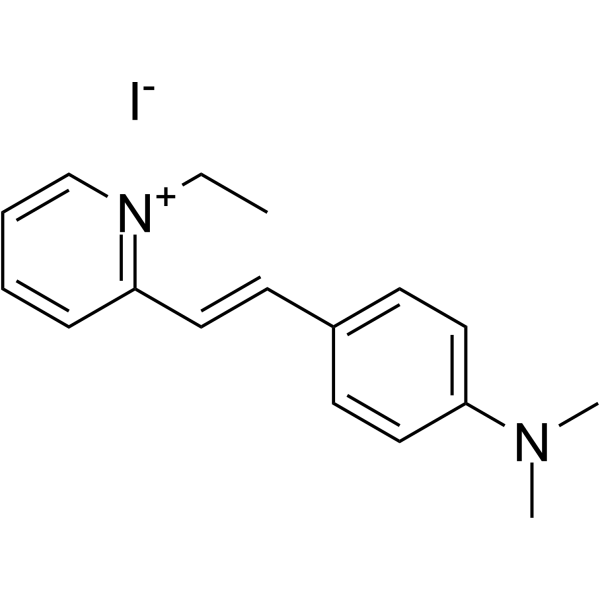2-(4-dimethylaminostyryl)-1-ethylpyridinium iodide

2-(4-dimethylaminostyryl)-1-ethylpyridinium iodide structure
|
Common Name | 2-(4-dimethylaminostyryl)-1-ethylpyridinium iodide | ||
|---|---|---|---|---|
| CAS Number | 3785-01-1 | Molecular Weight | 380.26700 | |
| Density | N/A | Boiling Point | N/A | |
| Molecular Formula | C17H21IN2 | Melting Point | 267ºC (dec.)(lit.) | |
| MSDS | Chinese USA | Flash Point | N/A | |
| Symbol |

GHS07 |
Signal Word | Warning | |
Use of 2-(4-dimethylaminostyryl)-1-ethylpyridinium iodideDASPEI is a fluorescent dye. DASPEI is a styryl dye that stains mitochondria of live cells. DASPEI has a large fluorescence Stokes shift and is taken up relatively slowly as a function of membrane potential[1]. |
| Name | 2-(4-dimethylaminostyryl)-1-ethylpyridinium iodide |
|---|---|
| Synonym | More Synonyms |
| Description | DASPEI is a fluorescent dye. DASPEI is a styryl dye that stains mitochondria of live cells. DASPEI has a large fluorescence Stokes shift and is taken up relatively slowly as a function of membrane potential[1]. |
|---|---|
| Related Catalog | |
| References |
| Melting Point | 267ºC (dec.)(lit.) |
|---|---|
| Molecular Formula | C17H21IN2 |
| Molecular Weight | 380.26700 |
| Exact Mass | 380.07500 |
| PSA | 7.12000 |
| LogP | 0.23440 |
| InChIKey | AMAXNNVXIBDEMV-UHFFFAOYSA-M |
| SMILES | CC[n+]1ccccc1C=Cc1ccc(N(C)C)cc1.[I-] |
CHEMICAL IDENTIFICATION
HEALTH HAZARD DATAACUTE TOXICITY DATA
|
| Symbol |

GHS07 |
|---|---|
| Signal Word | Warning |
| Hazard Statements | H315-H319-H335 |
| Precautionary Statements | P261-P305 + P351 + P338 |
| Personal Protective Equipment | dust mask type N95 (US);Eyeshields;Gloves |
| Hazard Codes | Xi: Irritant; |
| Risk Phrases | 36/37/38 |
| Safety Phrases | 26-36 |
| RIDADR | NONH for all modes of transport |
| RTECS | UU3971000 |
|
In silico activity profiling reveals the mechanism of action of antimalarials discovered in a high-throughput screen.
Proc. Natl. Acad. Sci. U. S. A. 105 , 9059-64, (2008) The growing resistance to current first-line antimalarial drugs represents a major health challenge. To facilitate the discovery of new antimalarials, we have implemented an efficient and robust high-... |
|
|
Imaging of Plasmodium liver stages to drive next-generation antimalarial drug discovery.
Science 334 , 1372-7, (2011) Most malaria drug development focuses on parasite stages detected in red blood cells, even though, to achieve eradication, next-generation drugs active against both erythrocytic and exo-erythrocytic f... |
|
|
The role of efflux systems and the cell envelope in fluorescence changes of the lipophilic cation 2-(4-dimethylaminostyryl)-1-ethylpyridinium in Escherichia coli.
Biochim. Biophys. Acta 1278(2) , 205-12, (1996) The interaction of the fluorescent dye 2-(4-dimethylaminostyryl)-1-ethlypyridinium cation (DMP+) with cells of Escherichia coli AN120 (uncA) and AS-1 (acrA) was studied to elucidate the role of the en... |
| GNF-Pf-1399 |
| 2-[4-(Dimethylamino)styryl]-1-ethylpyridinium iodide |
| GNF-Pf-4643 |
| 4-[2-(1-ethylpyridin-1-ium-2-yl)ethenyl]-N,N-dimethylaniline,iodide |
| GNF-Pf-2708 |
| MFCD00011994 |
| EINECS 223-248-3 |